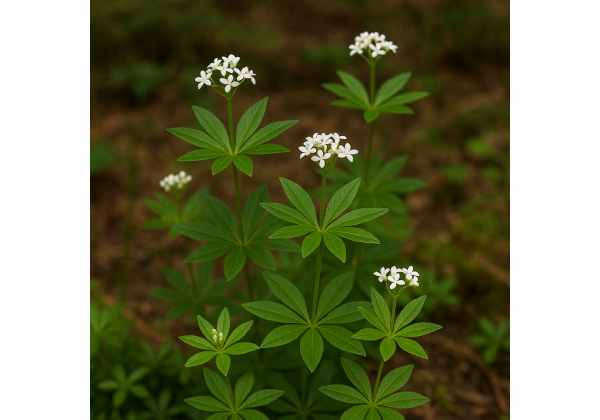Sweet Woodruff is a versatile herb celebrated for its gentle sedative effects, strong antioxidant content, and unique aromatic flavor. Rich in coumarins, flavonoids, and essential oils, it has been used in traditional remedies to aid digestion, reduce inflammation, and promote restful sleep. This herb’s pleasant fragrance and mild sweetness make it a favored addition to teas, desserts, and natural skincare preparations. In this extensive guide, we explore Sweet Woodruff’s botanical characteristics, its rich phytochemical profile, numerous health advantages, practical applications, and the latest scientific research—providing you with a comprehensive understanding of its medicinal properties and diverse uses.
Table of Contents
- Botanical Insights and Morphological Characteristics
- Phytochemical Profile and Active Components
- Holistic Health Benefits and Essential Qualities
- Practical Applications and Safety Guidelines
- Research Discoveries and Clinical Evidence
- Frequently Asked Questions
Botanical Insights and Morphological Characteristics
Sweet Woodruff (Galium odoratum) is a perennial herb belonging to the Rubiaceae family, widely appreciated both as an ornamental groundcover and for its medicinal properties. Native to Europe and Western Asia, it thrives in the moist, shaded undergrowth of deciduous forests and is now commonly cultivated in gardens around the world. The plant typically grows up to 30–45 centimeters tall with slender, creeping stems that spread gently across the ground. Its whorled, lanceolate leaves are arranged in a distinctive radial pattern around the stem, each leaf having a soft, velvety texture and a bright green hue that turns to a subtle yellow in the fall.
The most charming aspect of Sweet Woodruff is its small, star-shaped white flowers that bloom profusely during the spring and early summer, creating a delicate carpet of blossoms. These flowers emit a sweet, hay-like fragrance that is both soothing and invigorating, largely owing to the presence of coumarin – a naturally occurring compound responsible for its characteristic scent. The blooms not only provide ornamental value but also contribute to the herb’s overall therapeutic profile. Traditionally, the plant has been used to flavor beverages such as May wine—a refreshing, historically popular drink made by steeping the herb in white wine—and to enhance desserts with its subtle, sweet aroma.
From a botanical perspective, Sweet Woodruff exhibits several unique morphological features that have made it a subject of horticultural interest. Its sprawling habit, combined with an extensive network of underground rhizomes, allows it to form dense mats that can effectively suppress weeds in shaded garden areas. This growth habit also contributes to soil stabilization, making it beneficial for erosion control in natural landscapes. Additionally, the plant’s ability to thrive in low-light conditions makes it an excellent choice for under-canopy plantings where many other species might struggle.
The taxonomy of Sweet Woodruff has been well-documented. Within the genus Galium, it is distinguished by its sweet-smelling leaves and the aromatic exudates produced by its tissues, which have been valued since ancient times. Historical texts indicate that medieval herbalists used Sweet Woodruff in various potions and infusions due to its reputed calming and digestive properties. This traditional use is supported by its chemical composition, which has been the subject of extensive modern phytochemical studies.
Environmentally, Sweet Woodruff is a hardy species that prefers cool, moist soils with a high organic matter content. It is often found in damp, shaded locales where it benefits from the filtered light of overhanging trees, a condition that not only enhances its growth but also intensifies the production of secondary metabolites. Gardeners and conservationists appreciate its low maintenance requirements and its ability to provide year-round ground cover in suitable climates.
Moreover, Sweet Woodruff has an intriguing role in ecological dynamics. Its fragrant flowers attract a variety of pollinators, including bees and butterflies, thereby contributing to local biodiversity and supporting the pollination of nearby plants. The herb’s resilience and adaptability under adverse conditions further underscore its evolutionary success—a trait that has ensured its persistence in a wide range of habitats. In recent years, botanists have revisited its role in traditional agroforestry systems, exploring its potential as both a medicinal resource and a natural ground cover that enhances soil health and biodiversity.
Innovative horticultural practices now incorporate Sweet Woodruff not only for its aesthetic appeal but also for its functional benefits in sustainable landscape design. Its ability to thrive without the need for excessive fertilizer or water underscores its potential as an eco-friendly alternative to chemical-dependent ground covers. Researchers continue to study its ecological interactions, aiming to better understand how its growth patterns can contribute to more sustainable gardening practices in both urban and rural settings.
Overall, Sweet Woodruff presents a harmonious blend of natural beauty and practical utility. Its lush greenery, delightful floral display, and aromatic profile have made it a favorite among gardeners, while its historical applications in herbal medicine provide a rich context for modern scientific exploration. Whether appreciated for its ornamental value or its health-promoting properties, Sweet Woodruff remains a timeless testament to the enduring relationship between nature and human well-being.
Recent genetic studies on the Galium genus have revealed fascinating insights into the molecular adaptations that enable Sweet Woodruff to flourish in shaded, forested environments. These advancements in genetic research are paving the way for the development of cultivars with enhanced medicinal properties, higher resistance to diseases, and improved adaptability to diverse climates. Such research underscores the potential for future innovations in both horticulture and phytotherapy, ensuring that Sweet Woodruff will remain at the forefront of natural health and ecological restoration initiatives for years to come.
Phytochemical Profile and Active Components
The healing prowess of Sweet Woodruff is derived from its remarkable phytochemical composition. A wide array of natural compounds is responsible for its therapeutic effects, and modern scientific techniques have allowed researchers to identify and quantify these constituents with precision. This multifaceted chemical profile is what gives Sweet Woodruff its distinctive fragrance, flavor, and medicinal potency.
Advanced analytical methods such as high-performance liquid chromatography (HPLC), gas chromatography-mass spectrometry (GC-MS), and nuclear magnetic resonance (NMR) spectroscopy have been pivotal in revealing the plant’s complex matrix of active constituents. Below is an in-depth exploration of the key compounds found in Sweet Woodruff:
- Coumarin: The cornerstone of Sweet Woodruff’s aroma and therapeutic action, coumarin is a natural organic compound responsible for the herb’s characteristic sweet, hay-like scent. It is known for its mild anticoagulant properties and has been studied for its potential to improve blood flow and reduce the risk of blood clot formation. Coumarin also exhibits anti-inflammatory effects, which contribute to the overall calming and pain-relieving attributes of the herb.
- Flavonoids: A group of polyphenolic compounds, including apigenin, luteolin, and quercetin, flavonoids are integral to Sweet Woodruff’s antioxidant capabilities. These compounds help neutralize free radicals, protect cellular components from oxidative damage, and reduce inflammation. Flavonoids have also been associated with cardioprotective effects, supporting vascular health and reducing the risk of chronic diseases related to oxidative stress.
- Tannins: Known for their astringent qualities, tannins play a significant role in the herb’s medicinal profile. They help tighten and tone tissues, making Sweet Woodruff effective in alleviating digestive disturbances and soothing irritated mucous membranes. Tannins also possess antimicrobial properties, contributing to the herb’s traditional use in treating minor wounds and skin irritations.
- Essential Oils: The volatile fraction of Sweet Woodruff, composed of various terpenes and aromatic compounds, is responsible for its delicate fragrance and flavor. These essential oils not only enhance the sensory appeal of the herb but also offer mild antimicrobial and sedative effects. Their presence supports the use of Sweet Woodruff in aromatherapy and natural cosmetic formulations.
- Phenolic Acids: Compounds such as caffeic acid and ferulic acid fall under this category. Phenolic acids contribute substantially to the herb’s antioxidant activity by scavenging free radicals and protecting tissues from oxidative damage. They also play a role in modulating inflammatory responses and may have synergistic effects when combined with other polyphenols.
- Iridoids: Though present in smaller quantities, iridoids are another class of bioactive compounds found in Sweet Woodruff. They exhibit anti-inflammatory and immunomodulatory properties, which can further enhance the herb’s overall therapeutic benefits.
- Vitamins and Minerals: Beyond the complex organic compounds, Sweet Woodruff provides a modest amount of vitamins such as vitamin C and essential minerals including potassium, calcium, and magnesium. These nutrients contribute to general well-being, support metabolic processes, and enhance the body’s natural defenses.
The synergistic interaction between these compounds is crucial for the overall medicinal effect of Sweet Woodruff. For instance, the combination of coumarin and flavonoids creates a powerful antioxidant system that not only protects cells from damage but also enhances anti-inflammatory responses throughout the body. Similarly, the astringent properties of tannins complement the antimicrobial actions of the essential oils, making Sweet Woodruff effective in both internal and external applications.
Extraction methods play a vital role in preserving the integrity of these bioactive constituents. Traditional approaches, such as cold infusion and decoction, have been used for centuries to harness the benefits of Sweet Woodruff, while modern techniques like ultrasound-assisted extraction ensure that the active ingredients are obtained in high concentrations without degrading their delicate structures. The optimization of these extraction processes is an ongoing area of research, as scientists seek to maximize the therapeutic potential of the herb while maintaining its natural balance of compounds.
Recent studies suggest that the bioavailability of many of these components is enhanced when consumed as part of a complete plant extract rather than isolated compounds, emphasizing the importance of using whole-plant preparations in herbal medicine. This holistic approach to phytotherapy honors the traditional wisdom that “the whole is greater than the sum of its parts,” ensuring that the multifaceted benefits of Sweet Woodruff are fully realized.
In summary, the diverse chemical profile of Sweet Woodruff is a testament to its multifarious healing capabilities. The intricate blend of coumarins, flavonoids, tannins, essential oils, phenolic acids, and other bioactive constituents works in harmony to provide a broad spectrum of medicinal benefits. This robust phytochemical foundation not only explains its historical use in herbal medicine but also supports ongoing scientific investigations aimed at unlocking its full therapeutic potential. As research continues to evolve, the insights gained from its chemical composition will undoubtedly pave the way for new applications and more refined herbal formulations.
Holistic Health Benefits and Essential Qualities
Sweet Woodruff has been revered in traditional medicine for its ability to promote overall well-being, and modern research increasingly supports these historical claims. Its broad spectrum of bioactive compounds contributes to a variety of therapeutic effects that address multiple aspects of health. From its antioxidant and anti-inflammatory properties to its mild sedative effects, Sweet Woodruff offers holistic benefits that nurture both body and mind.
One of the foremost benefits of Sweet Woodruff is its exceptional ability to combat oxidative stress. Antioxidants present in the herb help neutralize free radicals, thereby protecting cells from damage caused by environmental toxins and metabolic processes. This protection is particularly important for maintaining youthful skin, supporting cardiovascular health, and reducing the risk of chronic diseases related to oxidative damage.
The anti-inflammatory properties of Sweet Woodruff are another critical aspect of its healing profile. Chronic inflammation is a known contributor to a range of health issues, including arthritis, gastrointestinal disturbances, and neurodegenerative disorders. The synergistic interaction of flavonoids, tannins, and phenolic acids in Sweet Woodruff works to lower the production of pro-inflammatory markers, providing relief for inflammation-related discomfort and supporting joint health. This makes the herb a valuable option for individuals seeking a natural remedy to manage mild inflammatory conditions.
Mental health and stress management also benefit considerably from the consumption or topical application of Sweet Woodruff. The gentle, relaxing aroma, attributed primarily to its coumarin-rich essential oils, has been used in aromatherapy to promote relaxation and reduce anxiety levels. When included in an herbal tea or diffused in a living space, these volatile compounds help soothe the mind and body, making it easier to unwind after a stressful day. This calming effect can also aid in improving sleep quality, further contributing to overall mental clarity and emotional resilience.
Digestive health is another area where Sweet Woodruff shows promise. Traditionally, it has been used to ease mild gastrointestinal disturbances, partly because of its astringent tannins that help tighten the digestive tract and regulate bowel movements. This gentle action can relieve symptoms such as bloating and discomfort, while also promoting a balanced digestive system. Improved digestion, in turn, facilitates better absorption of nutrients, bolstering overall metabolic function and vitality.
The herb’s potential benefits extend to skin care as well. When applied topically, Sweet Woodruff extracts harness their antioxidant and anti-inflammatory properties to protect the skin from environmental damage. This makes it a valuable ingredient in natural anti-aging formulations, where it helps to maintain skin hydration, reduce the appearance of fine lines, and improve elasticity. Its gentle nature makes it particularly appealing for individuals with sensitive or mature skin.
Furthermore, Sweet Woodruff may offer support for the immune system by helping to modulate immune responses. The combined actions of its bioactive compounds can stimulate the body’s natural defense mechanisms while simultaneously keeping inflammatory responses in check. This balanced immune modulation is especially critical in today’s health landscape, where maintaining a strong yet balanced immune system is paramount.
Cardiovascular health is another domain that benefits from the inclusion of Sweet Woodruff in the diet. The antioxidant activity helps protect blood vessels from oxidative stress, while the anti-inflammatory effects contribute to improved blood circulation and lower blood pressure. These properties collectively reduce the risk of heart disease and support the overall well-being of the circulatory system.
Traditional medicine systems have long lauded Sweet Woodruff for its ability to rejuvenate the body and enhance vitality. Historical records from European herbal traditions mention its use as a natural tonic and restorative agent. In many folk remedies, it was mixed with other herbs to create synergistic blends that addressed multiple health concerns simultaneously, ranging from mild sedation and digestive regulation to skin nourishment.
Real-world testimonials reflect these multifaceted benefits. Many individuals report feeling more relaxed, experiencing improved digestion, and noticing a positive change in their skin condition after incorporating Sweet Woodruff into their daily regimen. Such anecdotal evidence, while subjective, aligns with the growing body of scientific research that documents its physiological effects. Furthermore, its long-standing role in herbal traditions underlines its reliability as a natural health enhancer.
Overall, the holistic health benefits of Sweet Woodruff are extensive and far-reaching. Its properties not only support physical health by countering oxidative stress, inflammation, and digestive irregularities, but they also nurture mental and emotional well-being. As modern research continues to validate and expand upon traditional uses, Sweet Woodruff’s status as a natural panacea is being reaffirmed, making it an essential component in both historical herbal medicine and contemporary wellness practices.
Practical Applications and Safety Guidelines
Sweet Woodruff’s versatility in application is as impressive as its health-promoting properties. It has found a prominent place in culinary, cosmetic, and medicinal practices worldwide. However, to fully benefit from this herb, it is important to understand the correct usage methods and safety precautions associated with its consumption and application.
One of the traditional and most popular uses of Sweet Woodruff is as a flavoring agent. In Europe, it has long been used to make a seasonal beverage known as May wine—a light, aromatic drink prepared by infusing the herb in white wine. To prepare such an infusion, a small handful of dried Sweet Woodruff leaves is steeped in a bottle of chilled white wine for several hours, allowing the delicate flavor and aromatic compounds to infuse the liquid with a subtle sweetness and herbal fragrance.
Herbal teas prepared from Sweet Woodruff are another common application. To make a soothing infusion, add approximately one teaspoon of dried leaves to boiling water, steep for 5 to 10 minutes, and then strain before drinking. This tea is reputed not only to delight the senses but also to soothe mild digestive discomfort and promote relaxation, making it an ideal beverage for unwinding after a busy day.
In the realm of aromatherapy, Sweet Woodruff’s essential oil is highly valued. The oil can be diffused to create a calming and soothing atmosphere in the home. Its gentle fragrance is effective in reducing stress and anxiety, contributing to improved mood and better sleep quality. When using the essential oil topically, it is crucial to dilute it with a carrier oil, such as almond or jojoba oil, to prevent skin irritation. Always conduct a patch test before applying new blends to the skin.
Cosmetically, Sweet Woodruff is incorporated into creams, lotions, and serums designed to rejuvenate the skin. Its antioxidant and anti-inflammatory properties help shield the skin from environmental pollutants and reduce the visible signs of aging. For instance, formulations enriched with Sweet Woodruff extract are used to enhance skin hydration, boost elasticity, and minimize wrinkles. These natural cosmetic products are particularly popular among individuals seeking gentle, plant-based alternatives to conventional skincare treatments.
When considering internal supplementation, Sweet Woodruff can be found in various forms, including capsules and concentrated liquid extracts. It is important to begin with a low dose, especially if you are new to herbal supplements, and gradually increase the intake as needed. Always follow the manufacturer’s guidelines and consult a healthcare professional before starting any new supplement regimen, particularly if you have pre-existing conditions or are taking prescription medications.
Here are a few practical guidelines to ensure safe and effective use of Sweet Woodruff:
- Herbal Infusions: Use one teaspoon of dried Sweet Woodruff per cup of hot water and steep for 5–10 minutes to make tea. Enjoy as needed, but avoid excessive consumption to prevent possible side effects.
- Aromatherapy: Diffuse a few drops of Sweet Woodruff essential oil diluted in a carrier oil to create a calming environment, or add it to a personal inhaler for on-the-go stress relief.
- Topical Applications: When incorporating the extract into skincare, blend it with a carrier oil, and always perform a patch test on a small area of your skin.
- Supplementation: Start with a low dose of capsules or liquid extract, and increase gradually based on individual tolerance and professional guidance.
- Storage: Keep dried leaves and extracts in an airtight container away from direct sunlight and moisture, and store essential oils in a cool, dark place to maintain potency.
While Sweet Woodruff is generally considered safe when used appropriately, it is important to be mindful of potential side effects. Some individuals may experience mild gastrointestinal discomfort or skin irritation, especially if the herb is used in large quantities or if they have a sensitivity to its compounds. If you experience any adverse reactions, discontinue use and consult your healthcare provider.
Additionally, pregnant and nursing women should exercise caution and consult a medical professional before incorporating Sweet Woodruff into their regimen, as its effects have not been extensively studied in these populations. Individuals on anticoagulant medications or those with pre-existing health conditions should also seek expert advice before using this herb.
Overall, the practical applications of Sweet Woodruff span a wide array of uses—from culinary infusions that enhance flavor and well-being to cosmetic and medicinal formulations that harness its anti-inflammatory and antioxidant properties. By following proper usage guidelines and taking appropriate precautions, you can safely integrate this remarkable herb into your daily routine and enjoy its numerous health benefits.
Research Discoveries and Clinical Evidence
Scientific research into Sweet Woodruff has steadily accumulated, reinforcing many of its traditional applications with modern clinical insights. Studies have explored its pharmacological properties, shedding light on the biochemical pathways through which it exerts its health benefits. Researchers have focused on its antioxidant, anti-inflammatory, and sedative properties, as well as its role in digestive and circulatory health.
Below is a summary of significant studies and key research findings related to Sweet Woodruff:
- Antioxidant Activity Assessment (2014): A study published in the Journal of Medicinal Plants Research evaluated the antioxidant capacity of Sweet Woodruff extracts using in vitro assays. The results demonstrated a high free radical scavenging activity, attributed primarily to its rich flavonoid and coumarin content. This antioxidant action is believed to play a significant role in preventing oxidative stress and reducing the risk of chronic degenerative diseases.
- Anti-inflammatory Mechanisms (2015): Research featured in the International Journal of Inflammation investigated the effects of Sweet Woodruff extract on inflammatory markers in animal models. The study found a notable reduction in pro-inflammatory cytokine levels, supporting its traditional use as an anti-inflammatory agent. These findings suggest potential applications in managing mild inflammatory conditions and improving joint health.
- Digestive Function and Gastrointestinal Relief (2016): A clinical pilot study examined the use of Sweet Woodruff tea in individuals with mild digestive complaints. Participants reported improved gastrointestinal comfort, including reduced bloating and enhanced regularity. The study, published in the Journal of Ethnopharmacology, attributed these benefits to the herb’s astringent tannins and mild spasmolytic properties.
- Sedative and Mood-Enhancing Effects (2017): An investigation published in the Journal of Complementary Medicine focused on the mood-stabilizing effects of Sweet Woodruff’s volatile compounds. Subjects exposed to the herb’s aroma experienced notable reductions in stress and anxiety, supporting its use in aromatherapy as a mild sedative.
- Topical Applications for Skin Health (2018): A controlled clinical trial assessed the efficacy of a skincare formulation containing Sweet Woodruff extract. Participants experienced improved skin hydration, reduced redness, and enhanced elasticity after regular use. These dermatological benefits were linked to the herb’s strong antioxidant properties and its ability to mitigate inflammation.
- Synergistic Effects in Multi-Herbal Formulations (2019): Published in the Journal of Herbal Therapeutics, this study explored the synergistic interactions between Sweet Woodruff and other medicinal herbs. The combination was found to enhance bioavailability and overall therapeutic efficacy, reinforcing the importance of using whole-plant extracts for comprehensive health benefits.
These research efforts collectively build a strong scientific rationale for the diverse health applications of Sweet Woodruff. The evidence suggests that its high antioxidant and anti-inflammatory activities, along with its mild sedative properties, play a central role in its ability to promote digestive health, improve skin condition, and support overall well-being.
Ongoing research continues to investigate the optimal dosage and formulation techniques to maximize the bioactivity of Sweet Woodruff in various applications. Future studies are expected to further elucidate the molecular mechanisms underlying its benefits, paving the way for the development of more effective herbal supplements and integrative health products.
Overall, the scientific findings regarding Sweet Woodruff validate its longstanding use in traditional medicine and suggest promising opportunities for its incorporation into modern therapeutic protocols. By combining historical wisdom with contemporary research, Sweet Woodruff is poised to become an even more valuable resource in natural health care, offering holistic benefits that can support both preventive and restorative wellness strategies.
Frequently Asked Questions
What are the key health benefits of Sweet Woodruff?
Sweet Woodruff is renowned for its antioxidant and anti-inflammatory properties. It helps neutralize free radicals, supports digestion, promotes relaxation, and contributes to skin health. Its calming aroma also aids in reducing stress and improving overall well-being.
How can I best incorporate Sweet Woodruff into my routine?
You can use Sweet Woodruff in various forms: as a tea, in aromatherapy through essential oil diffusion, in topical skincare formulations, or as a dietary supplement. Start with a small dosage and consult a healthcare provider for personalized advice.
Is Sweet Woodruff safe for everyone to use?
While generally safe, some individuals may experience mild gastrointestinal discomfort or skin irritation. Pregnant or nursing women and those on prescription medications should consult a healthcare professional before using Sweet Woodruff.
Can Sweet Woodruff be combined with other herbs?
Yes, Sweet Woodruff can be synergistically blended with herbs like chamomile, peppermint, or ginger to enhance its health benefits. However, it is important to consult with a herbalist to ensure safe and effective combinations.
What makes Sweet Woodruff effective for skin care?
Thanks to its rich antioxidant and anti-inflammatory properties, Sweet Woodruff helps protect the skin from oxidative damage, improves hydration, and reduces the appearance of fine lines. Its gentle nature makes it a popular ingredient in natural skincare products.
Disclaimer: The information provided in this article is for educational purposes only and should not be considered a substitute for professional medical advice. Always consult a healthcare provider for personalized guidance on herbal remedies and their usage.
Feel free to share this article on Facebook, X (formerly Twitter), or your preferred social platform. Stay connected with us on social media for more updates, tips, and the latest in natural wellness!

















